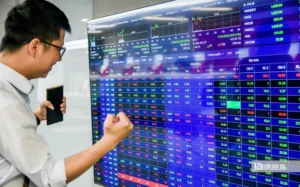By mid-December, credit had increased by about 12.5%, reaching about 15.3 quadrillion VND. According to the State Bank’s report, capital flows focused mainly on priority sectors.
The State Bank needs to focus on implementing more drastic and effective tasks and solutions on interest rate management , exchange rate, credit growth , and reducing lending interest rates to meet the capital needs of the economy. This is an important direction of the Prime Minister for the banking sector, in Official Dispatch No. 135 on continuing to strengthen solutions for interest rate and credit management.
As of mid-December, credit had increased by about 12.5%, reaching about VND15.3 quadrillion. According to the State Bank’s report, capital flows were mainly concentrated in priority sectors.
Credit structure chart by sector. The green area is probably the agricultural and rural loans that account for the highest proportion, at 23.7% of the total outstanding debt of the entire economy. The red area is capital for small and medium enterprises, accounting for nearly 17.5%. The yellow area is consumer loans, serving life, also accounting for more than 21.3% of the total outstanding debt.
It is noteworthy that in terms of growth rate, many sectors are growing at a higher rate than the average. By the end of October, loans to supporting industries increased by 21%, while loans to high-tech enterprises increased by 29%. Capital flows are tending to flow more strongly into production and business, and to enterprises focusing on improving product quality.
The food scanner detects any foreign objects on the product, even a small piece of metal of 1mm, and the machine will automatically stop. Thanks to that, businesses can ensure that 100% of products do not contain foreign objects for export to demanding markets.
To invest in a modern food and vegetable processing line, the enterprise must spend tens of billions of dong. But in return, productivity and product quality increase many times. 90% of the enterprise’s products have been exported to many countries around the world.
Mr. Dinh Cao Khue – Chairman of Dong Giao Doveco Food Export Joint Stock Company said: “Interest rates have been reduced by about 1%, which is very favorable for the company to have conditions for production, processing and export. The bank is on the same boat as us, understands agricultural production and processing and supports us in difficult times”.
In order to promptly meet the year-end loan demand, the State Bank had to extend the credit limit for the second time for banks with credit growth rates above 80% of the assigned target. This is to ensure that capital will be lent in the right direction, to the right areas that need capital. More importantly, it is to avoid the situation of massive lending without controlling the quality of loans.
“Credit demand will certainly grow higher. Businesses are also having to complete their debts for the year. International orders are also gradually increasing, and businesses are currently very excited and have many orders,” said Mr. Tran Hoai Nam – Deputy General Director of HDBank.
Mr. Nguyen Duc Lenh – Deputy Director of the State Bank of Vietnam, Ho Chi Minh City branch said: “Interest rates are very good, low interest rates, along with the expanded credit room and the high capital demand of the economy at the end of the year. Positive changes from tourism, trade and service activities, these two factors, both policy and environment, will directly impact credit growth, and credit growth in the last month of the year will be at its best.”
To achieve the credit growth target of 15% for the whole year, it is estimated that about VND300,000 billion will be lent out in the second half of December.
Banks promote cash flow lending
Data shows that capital demand is higher at the end of the year, and banks are also lending more. However, many businesses say they still have difficulty accessing capital if they do not have a red book to mortgage.
Not all businesses have enough real estate to mortgage, especially small businesses, and factories are rented. Therefore, banks are quite flexible, not requiring mortgage of red books to lend capital. However, banks cannot lend without any guarantee, in case the business cannot repay, bad debt will increase. To harmonize the interests of both businesses and banks, the solution of lending according to cash flow, or output orders, has been implemented by many banks.
The wood panels have been imported by the company to prepare for production orders. Because they specialize in large projects, the company has to spend several hundred thousand to a billion dong to buy raw materials in advance. Notably, they now do not have to mortgage their houses, but can borrow unsecured loans from banks.
Instead of requiring collateral, the bank will consider the value of the business’s output contracts and its operating revenue in previous years to calculate the business’s ability to repay the debt. From there, it will set a loan limit.
“The loan package is a guaranteed unsecured loan that helps businesses have good working capital so that small and medium enterprises can run projects smoothly without having to rotate capital more,” said Mr. Nguyen Xuan Nam – Director of Top Space Trading and Interior Joint Stock Company.
To lend without collateral, banks will have to work very closely with businesses on their business plans. They will often require businesses to transfer their transaction accounts to their bank so they can manage the cash flow of the business.
Mr. Nguyen Canh Hung – Director of SeABank Corporate Clients said: “We have to understand the business activities of customers, one of the biggest difficulties of businesses is collateral. When we design products, such as products to finance construction and installation businesses, we only need the business to sign a contract, then we will lend immediately. Thus, businesses do not need any other collateral such as external real estate or deposits, which is very convenient for businesses”.
“The cash flow in and out of each individual and business will reflect the nature of business activities and capital sources of customers to ensure transparency in capital use as well as demonstrate customer activities to the bank,” said Mr. Dang Quang Anh – Director of BVBank Hanoi branch.
Unsecured loans are often riskier. Therefore, the interest rates of these loans are also higher. And to limit the risk of bad debt, banks also apply technology and big data analysis to rank the financial health of businesses. From there, they make lending decisions.
In parallel with promoting lending, in the newly issued telegram, the Prime Minister also requested the State Bank to direct credit institutions to continue to implement more effectively and strongly solutions to reduce lending interest rates, support people and businesses to develop production and business, generate revenue, profit and repay loans to banks. At the same time, resolutely and strictly handle credit institutions that compete in unhealthy interest rates, not in accordance with regulations. Therefore, it requires banks to make efforts to improve service quality, in accordance with the directive spirit of not allowing congestion, delay, or creating a mechanism of asking for and giving, negative in granting credit.
















